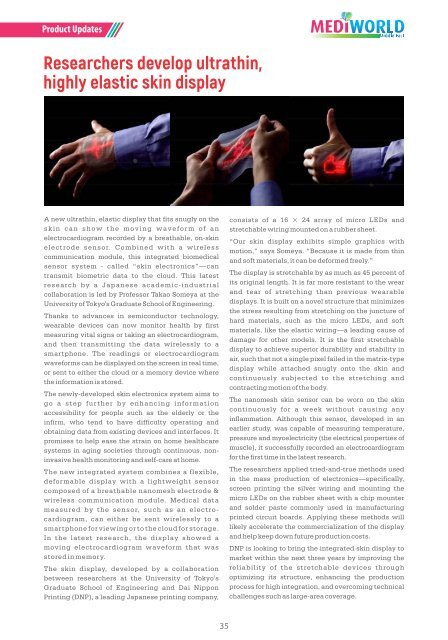Mediworld 07th MAR-APR Final Draft for Print
You also want an ePaper? Increase the reach of your titles
YUMPU automatically turns print PDFs into web optimized ePapers that Google loves.
Product Updates<br />
Researchers develop ultrathin,<br />
highly elastic skin display<br />
A new ultrathin, elastic display that fits snugly on the<br />
s k i n c a n s h o w t h e m o v i n g w a v e f o r m o f a n<br />
electrocardiogram recorded by a breathable, on-skin<br />
electrode sensor. Combined with a wireless<br />
communication module, this integrated biomedical<br />
sensor system - called “skin electronics”—can<br />
transmit biometric data to the cloud. This latest<br />
research by a Japanese academic-industrial<br />
collaboration is led by Professor Takao Someya at the<br />
University of Tokyo's Graduate School of Engineering.<br />
Thanks to advances in semiconductor technology,<br />
wearable devices can now monitor health by first<br />
measuring vital signs or taking an electrocardiogram,<br />
and then transmitting the data wirelessly to a<br />
smartphone. The readings or electrocardiogram<br />
wave<strong>for</strong>ms can be displayed on the screen in real time,<br />
or sent to either the cloud or a memory device where<br />
the in<strong>for</strong>mation is stored.<br />
The newly-developed skin electronics system aims to<br />
go a step fur ther by enhancing in<strong>for</strong> mation<br />
accessibility <strong>for</strong> people such as the elderly or the<br />
infirm, who tend to have difficulty operating and<br />
obtaining data from existing devices and interfaces. It<br />
promises to help ease the strain on home healthcare<br />
systems in aging societies through continuous, noninvasive<br />
health monitoring and self-care at home.<br />
The new integrated system combines a flexible,<br />
de<strong>for</strong>mable display with a lightweight sensor<br />
composed of a breathable nanomesh electrode &<br />
wireless communication module. Medical data<br />
measured by the sensor, such as an electro -<br />
cardiogram, can either be sent wirelessly to a<br />
smartphone <strong>for</strong> viewing or to the cloud <strong>for</strong> storage.<br />
In the latest research, the display showed a<br />
moving electrocardiogram wave<strong>for</strong>m that was<br />
stored in memory.<br />
The skin display, developed by a collaboration<br />
between researchers at the University of Tokyo's<br />
Graduate School of Engineering and Dai Nippon<br />
<strong>Print</strong>ing (DNP), a leading Japanese printing company,<br />
consists of a 16 × 24 array of micro LEDs and<br />
stretchable wiring mounted on a rubber sheet.<br />
“Our skin display exhibits simple graphics with<br />
motion,” says Someya. “Because it is made from thin<br />
and soft materials, it can be de<strong>for</strong>med freely.”<br />
The display is stretchable by as much as 45 percent of<br />
its original length. It is far more resistant to the wear<br />
and tear of stretching than previous wearable<br />
displays. It is built on a novel structure that minimizes<br />
the stress resulting from stretching on the juncture of<br />
hard materials, such as the micro LEDs, and soft<br />
materials, like the elastic wiring—a leading cause of<br />
damage <strong>for</strong> other models. It is the first stretchable<br />
display to achieve superior durability and stability in<br />
air, such that not a single pixel failed in the matrix-type<br />
display while attached snugly onto the skin and<br />
continuously subjected to the stretching and<br />
contracting motion of the body.<br />
The nanomesh skin sensor can be worn on the skin<br />
continuously <strong>for</strong> a week without causing any<br />
inflammation. Although this sensor, developed in an<br />
earlier study, was capable of measuring temperature,<br />
pressure and myoelectricity (the electrical properties of<br />
muscle), it successfully recorded an electrocardiogram<br />
<strong>for</strong> the first time in the latest research.<br />
The researchers applied tried-and-true methods used<br />
in the mass production of electronics—specifically,<br />
screen printing the silver wiring and mounting the<br />
micro LEDs on the rubber sheet with a chip mounter<br />
and solder paste commonly used in manufacturing<br />
printed circuit boards. Applying these methods will<br />
likely accelerate the commercialization of the display<br />
and help keep down future production costs.<br />
DNP is looking to bring the integrated skin display to<br />
market within the next three years by improving the<br />
reliability of the stretchable devices through<br />
optimizing its structure, enhancing the production<br />
process <strong>for</strong> high integration, and overcoming technical<br />
challenges such as large-area coverage.<br />
35

















